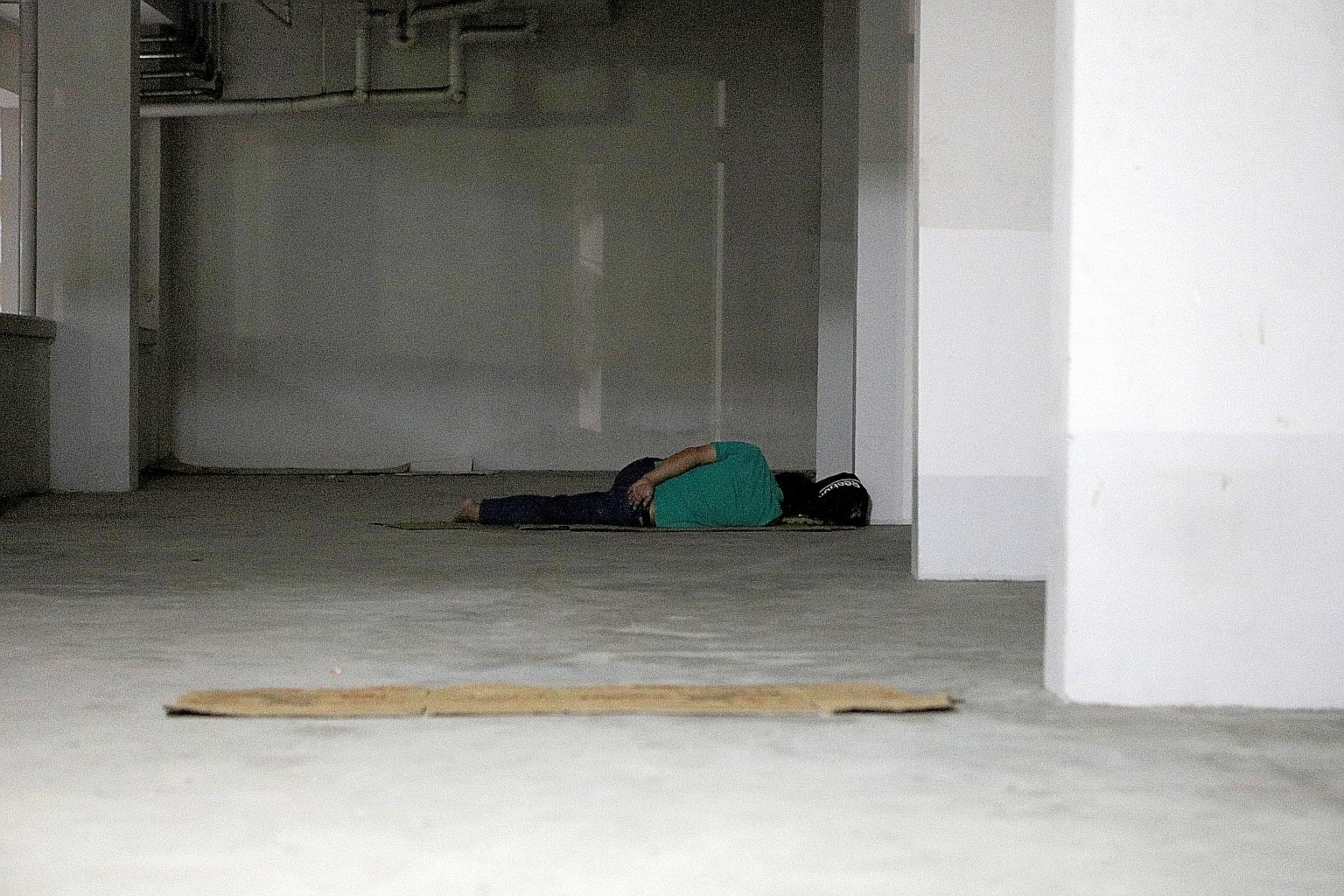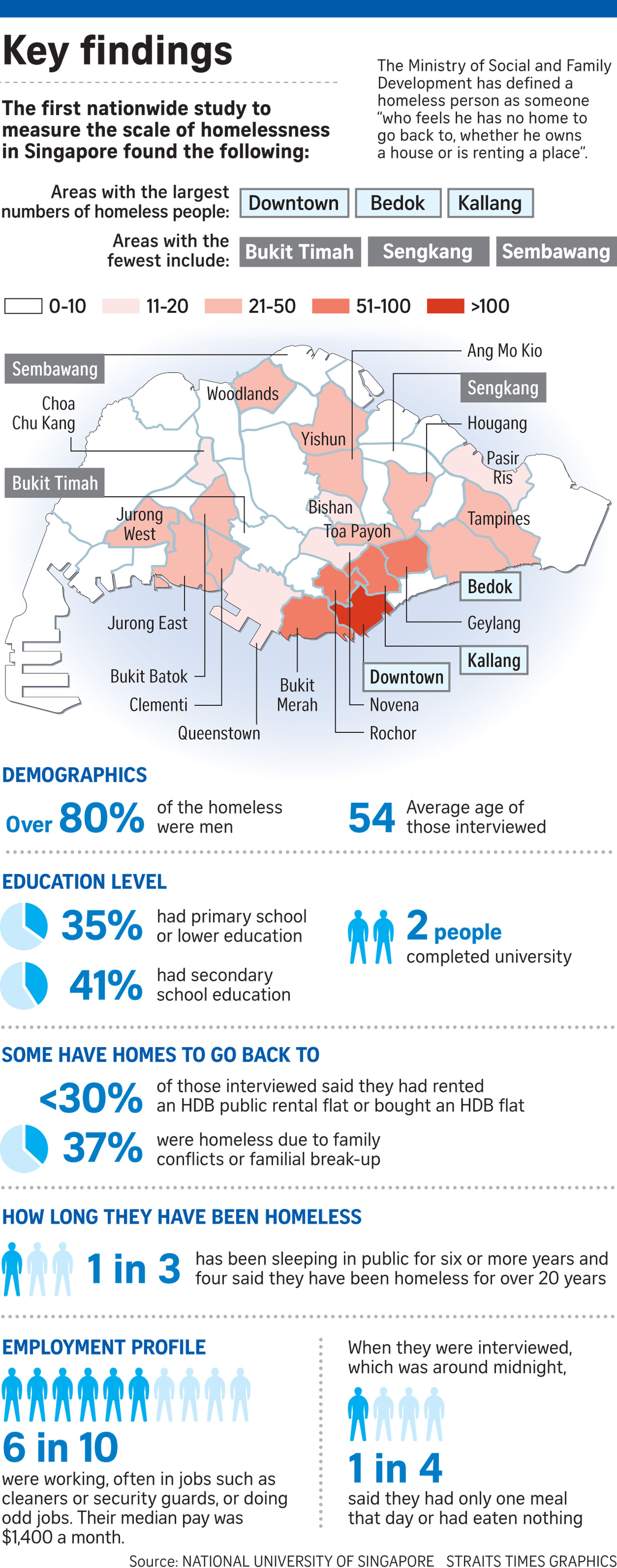1,000 homeless people sleeping on the streets in Singapore: Study
Six in 10 of the homeless interviewed in nationwide study were working, mostly in low-wage jobs
Sign up now: Get ST's newsletters delivered to your inbox

Half of the homeless had been toughing it out on the streets for between one and five years, and nearly one-third did so for six years or longer. They slept in places like void decks, commercial buildings and playgrounds. ST PHOTO: WANG HUI FEN
Follow topic:
The first nationwide study of homelessness in Singapore found that about 1,000 people were sleeping on the street.
They were sleeping rough in most parts of the island, but more were found in the older and larger housing estates such as in the city area, Bedok and Kallang.
These areas also had more rental flats, as homelessness is linked to poverty. The study did not specify which areas in the city it was referring to.
Over eight in 10 of the homeless were men and of those interviewed, six in 10 were working, mostly in low-wage jobs like cleaning and as security guards.
Half the number had been toughing it out on the streets for between one and five years, and nearly one-third did so for six years or longer.
They slept in places like void decks, commercial buildings and playgrounds.
The study was done by Assistant Professor Ng Kok Hoe of the Lee Kuan Yew School of Public Policy (LKYSPP) at the National University of Singapore.
He led a team of close to 500 volunteer fieldworkers who covered 12,000 blocks of flats and other public and commercial spaces over three months to count the numbers sleeping on the streets.
The fieldworkers, who started work after 11.30pm, recorded the number of people who were asleep or going to sleep in public spaces. These rough sleepers also had some form of bedding or many belongings.
The study also interviewed 88 of the homeless people.
Prof Ng said: "Homelessness exists in Singapore. But despite growing policy and public attention in recent years, the size of the homeless population in Singapore is not known. Knowing the number of homeless people and where they may be found allows services to be designed and organised in a systematic way."
The study, which was released yesterday, is an independent one funded by a research grant from the LKYSPP. The Ministry of Social and Family Development (MSF) also helped to mobilise social workers for the street count and asked the homeless interviewed if they are willing to seek help from government or social service agencies.
The key findings include:
• Some six in 10 of the homeless were working but their median wage was $1,400 a month, compared with the national median wage of $3,467.
• About half said they were sleeping on the street as they were unemployed, did not have regular jobs or earned very little. So they could not pay their rent or mortgage, or they had sold their house. Family conflicts and break-ups were cited as another main reason for homelessness.
• Some 26 per cent either rented a flat from the Housing Board at highly subsidised rates or bought an HDB flat. However, some chose not to go home because of conflicts with their co-tenant.
• Some 40 per cent of those interviewed had sought help in the past year. They did so from a number of places including the Social Service Offices which administer the Government's financial aid schemes or their Member of Parliament.
Prof Ng noted the complexity of their problems, saying that could be a reason why 40 per cent sought help but still found it hard to break out of their homeless predicament.

Mr Lee Kim Hua, a senior director at MSF, said the ministry defined a homeless person as someone "who feels he has no home to go back to, whether he owns a house or is renting a place".
He said: "As long as he doesn't feel safe going back at night to sleep, we take it as homelessness."
Mr Lee said the ministry has stepped up its partnership with community groups to reach out to and aid the homeless over the past two years. This is needed, as among other reasons, some of the homeless may be afraid of and shun help from the authorities but not staff and volunteers from charities.
So the key is for the community groups to engage them and build trust, and when they are ready, the ministry can extend the help needed.
The ministry has brought together the different groups helping the homeless and in July, the Partners Engaging and Empowering Rough Sleepers (Peers) Network was launched. It now has 26 members, such as the Catholic Welfare Services and the Homeless Hearts of Singapore.
Mr Lee said that the ministry is working with the Peers Network to build an interim shelter for those sleeping on the streets.
There are currently three transitional shelters catering to the homeless.

